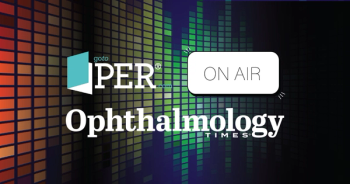
Confocal microscopy key to diagnosing infectious keratitis
For ophthalmologists, in vivo confocal microscopy facilitates a more rapid diagnosis compared with other diagnostic modalities - proving instrumental in saving vision.
This article was reviewed by Pedram Hamrah, MD, FACS
In vivo confocal microscopy has become valuable in diagnosing and following infectious keratitis.
For ophthalmologists, an important advantage is that the technology facilitates more rapid diagnosis compared with other diagnostic modalities. This can be instrumental in saving vision.
The technology is also well suited to following patients over time to monitor treatment progress, according to Pedram Hamrah, MD, FACS.
Dr. Hamrah is director, Center for Translational Ocular Immunology, New England Eye Center, Tufts Medical Center, and professor of ophthalmology, Tufts University School of Medicine, Boston.
Two in vivo confocal microscopy machines are in use although not commercially available. A slit-scanning confocal microscope (Confoscan 4, Nidek Technologies) uses a white light to visualize corneal structures and a has decreased scanning time. The other machine, a laser scanning confocal microscope (Heidelberg Retina Tomography, Heidelberg Engineering), uses a 600-nanometer laser. The machines are capable of imaging structures layer by layer from the epithelium to the endothelial cells.
These diseases can be diagnosed a few ways. The gold standard is by culture, which provides a definitive diagnosis, although a specimen can be difficult to obtain from deep tissue and may provide a low yield, and days to weeks are needed to reach a definitive diagnosis.
Corneal biopsy also provides a definitive diagnosis if the result is positive. The downsides are that there is potential for a sampling error and the procedure is invasive. Polymerase chain reaction (PCR) requires corneal scraping and may not provide a positive result.
Confocal microscopy is fast, provides an almost immediate answer and is the least invasive of the methodologies, Dr. Hamrah explained.
Diagnosis and management Acanthamoeba cysts appear in confocal microscopy images as spherical, round, ovoid, or pear- or egg-shaped hyperreflective structures. The cysts have a double-walled or star-shaped appearance and are 10 to 30 μm in diameter. Trophozoites are generally 25 to 40 μm and hard to see using the Confoscan but visible using laser confocal microscopy in untreated patients. Laser confocal microscopy also is sufficiently powerful to differentiate among cysts, leukocytes, and lymphocytes, but differentiating epithelial cells can be problematic.
“When comparing cysts and trophozoites, cysts can be seen best in clusters or chains,” Dr. Hamrah said. “However, once viewed, the clusters or chains are generally poor prognostic factors. They are signs of proliferation or represent a lack of response to therapy. In that case, surgery or a change of therapy may be indicated.”
The specificity and sensitivity of in vivo confocal microscopy are generally good, with specificities exceeding 76%, while the sensitivity can be lower. Studies from Moorfields Eye Hospital, London, and Massachusetts Eye and Ear, Boston, have reported lower sensitivities with less experienced operators.
After treatment, in vivo confocal microscopy can be used to monitor patients’ progress. “Using confocal microscopy, the cyst density decreases after treatment. In our experience, the rate of surgical interventions has decreased by following these patients,” Dr. Hamrah reported.
Fungal keratitis
These pathogens are differentiated based on the appearances of the various species involved. Fusarium solani is characterized by filamentous structures, Paecilomyces lilacinus by curved structures, Aspergillus structures are 5 to 10 μm in diameter with septate hyphae with dichotomous branches and 200 to 400 μm long, and Candida parapsilosis has sausage-like structures 10 to 40 μm long and 5 to 10 μm wide.
In addition to the shapes, the angles of the structures differ among the various pathogens, with Aspergillus and Fusarium structures at 45- and 90-degree angles, respectively.
The fungal structures can be difficult to differentiate from stromal nerves, which have a more regular branching pattern and are larger at 25 to 50 μm.
The sensitivities (>89%) and specificities (78% to 100%) for diagnosing fungal keratitis are better than those for acanthamoeba.
Other forms of keratitis Nocardia keratitis is a filamentous bacterium characterized by multiple short, beaded structures with right-angled branching and is 10 to 30 μm in diameter. Filamentous structures generally clump together and are visible in the epithelium and stroma.
Microsporidia keratitis appears as clusters of epithelial cells with bright borders in a rosette pattern. This bacterium is hyperreflective with pinpoint ovoid intracellular bodies and dot-like structures in surrounding epithelial areas.
Pythium insiduosum keratitis has hyperreflective double-walled filaments of various sizes. Two shapes have been documented: some hyperreflective lines are beaded and string-like, 3.5 to 7.5 μm in diameter, and can be as long as 400 μm long with mean branching angles of 78.6 degrees; other hyperreflective lines can be thin ranging from 1.5 to 2.8 μm in diameter and 150 to 370 μm long. This pathogen does not respond to antifungal therapy and surgery is usually needed, Dr. Hamrah pointed out.
Bacterial keratitis has a nonspecific appearance.
Dr. Hamrah concluded that acanthamoeba and fungal keratitis can be diagnosed rapidly and safely by in vivo confocal microscopy, which shortens the time from presentation to onset of treatment, and decreases in the number of cysts or fungal elements are observed with treatment.
Cysts appearing as chains or clusters indicate proliferative disease. Use of confocal microscopy for rapid diagnosis or monitoring of the treatment response may have the potential to improve the visual outcomes, and the technology also may help diagnose Nocardia, microsporidia, and Pythium keratitis.”
The situations in which confocal microscopy is helpful include unresponsive and atypical keratitis, culture- and PCR-negative keratitis, graft rejection versus recurrent infection in grafts, neurotrophic keratopathy, crystalline keratopathy, and guidance for medical and surgical management.
Pedram Hamrah, MD, FACS
E: [email protected]
Dr. Hamrah has no financial interest in any aspect of this report.
Newsletter
Don’t miss out—get Ophthalmology Times updates on the latest clinical advancements and expert interviews, straight to your inbox.





